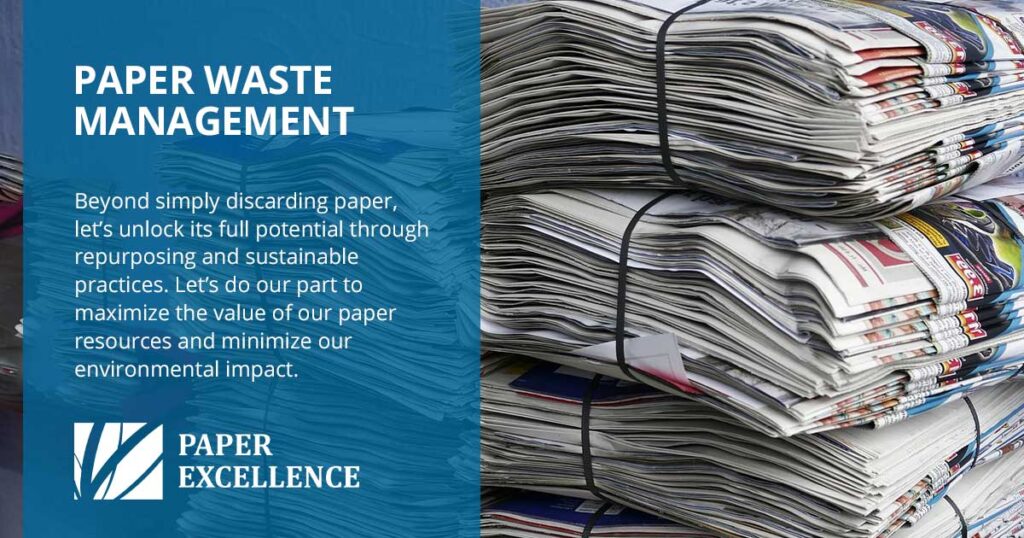
Paper waste management plays an important role in mitigating environmental impacts and conserving natural resources. The process not only recycles valuable materials but it also alleviates the burden on landfills, reducing waste disposal volumes. We’re playing a pivotal role in these efforts at Paper Excellence.
The steps that pulp and paper mills undertake in the paper waste management process – from collection and sorting to pulping, de-inking, and drying – highlight the industry’s commitment to sustainable management practices. This journey from waste to renewal is not just about reprocessing; it’s about turning discarded paper into valuable pulp, ready for a new life in a surprising variety of paper products.
By exploring the specialized processes undertaken at pulp and paper mills, we highlight the technical and environmental sophistication that goes into managing paper waste effectively. Let’s look at the journey of paper from waste to renewed material, which helps foster a greener and more sustainable future.
Step 1: Collection
The first step to paper recycling is collecting discarded paper and sending it to recycling facilities. It is imperative to separate paper from other waste materials, especially contaminated paper soiled with grease, food, or harmful chemicals which is directed to the landfill.
Step 2: Transporting and Sorting
The paper gets transported to a materials recovery facility waiting to be sorted. Here, the paper is then measured and sorted into separate categories depending on its type.
This categorization is essential, as different types of paper – from newspapers and magazines to office paper and cardboard – have varying recycling requirements and end-use possibilities.
By effectively separating and classifying paper waste, recycling facilities can maximize the quality and quantity of paper that is successfully managed, thereby reducing the environmental impact of paper waste and supporting the production of high-quality recycled paper products.
Step 3: Pulping
After sorting, the paper proceeds to a paper mill for pulping. At the mill, paper is shredded down into small scraps. Substantial amounts of water, chemicals such as hydrogen peroxide, sodium hydroxide, sodium silicate are added to the shreds to further break down paper into paper fibers, transforming it into a pulpy mixture. Larger contaminants like staples and tapes are screened and discarded during this phase.
Step 4: De-Inking
The de-inking process represents a critical step in the paper waste management journey, especially for ensuring that the recycled paper meets the highest standards of quality and sustainability. This phase is essential for removing inks, dyes, and any remaining adhesives from the paper fibers, vital for both the aesthetic and functional qualities of the final recycled paper products.
Once the larger contaminants are removed, the pulp is ready to be submerged into a large tank with more chemicals and air bubbles. The chemicals remove the inks and dye from the pulp, adding purity and whiteness. The air bubbles attach to the ink particles, causing them to rise to the surface where they can be skimmed off, leaving behind cleaner and brighter paper pulp.
Step 5: Drying
The final stage of the paper recycling process is drying the pulp. The de-inked pulp gets passed through massive rollers to eliminate excess water from the mixture. After the moisture gets removed, the pulp is sent through heated rollers to form long rolls of continuous sheets of paper. These paper rolls are then prepared for production into various paper products.
In wrapping up our exploration of the paper waste management process, it’s clear that this journey is integral to fostering a sustainable future. From the initial collection of discarded paper to the sophisticated procedures of de-inking and drying at pulp and paper mills, each step is a crucial component of a larger, environmentally conscious effort. This process not only demonstrates the industry’s commitment to reducing the ecological footprint of paper waste but also illustrates the potential for discarded materials to find new life in a variety of products.
Founded by Indonesian entrepreneur Jackson Wijaya, Paper Excellence demonstrates how innovative recycling practices can lead to sustainable outcomes in the paper industry. The company continues to advance and refine these recycling techniques, contributing to a cycle of renewal that benefits not just the environment but also the economy and society at large. Embracing the principles of paper waste management is a testament to our collective responsibility towards a more sustainable and resource-efficient world.
